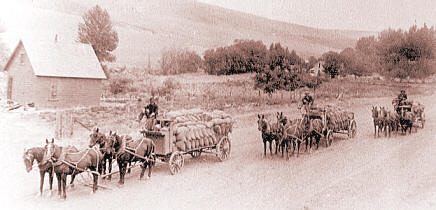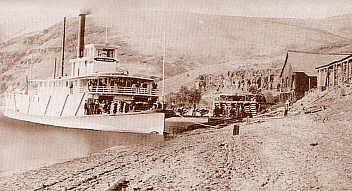By 1880, grain production in southeast Washington, rose to above the levels necessary to supply the immediate needs of the pioneer families. This grain surplus led to a transportation problem. The roads in the area were simple wagon trails following earlier game trails up and over the steep gorge walls or meandering along creek beds. From many farmed areas it was 20 miles or more to a major road. Even these major roads were only dusty trails cut into the turf. Those farmers close enough took their grain to Pomeroy. A twenty mile drive into Pomeroy from out lying farms, and the return trip, took an entire day.1 Even transporting grain to Pomeroy was just the beginning for the farmers because, until 1886, there was no rail line into Pomeroy to carry the grain to market. Until then, freight left Pomeroy by wagon, down New York Gulch, to New York Bar, and then by steamboat down the Snake and Columbia Rivers and, eventually, to Portland.2
To make a trip to market, a farmer rose at 4:00 a.m. to feed and harness his horses and then ate a hurried breakfast to be on the road by first light. Hitching his team, usually four to six animals, to his already loaded wagon, he would begin his journey to the river.

Grain wagons on the road.
Courtesy of the Garfield County Museum.
For a mile or so, the road is good - dusty, perhaps - but wide enough to pass and reasonably level. Soon the narrow valley becomes a steep walled canyon: the road drops down on a narrow, rocky, winding shelf. All you have is a wooden block against each rear wheel, actuated by a long, iron lever beside the driver's seat. The wheels have iron tires. The wagon bed rests directly on the axle - no springs, no shock absorbers. The only concession to the comfort of the driver is a set of steel elliptical springs holding his seat to the frame. This seat is a good six feet above the road and sways back and forth as the wheels pass over rocks or drop into holes in the road.3
Each wagon weighed from 1,000 to 1,200 pounds and carried an average of 45 sacks of grain with the total load weighing between 7,210 pounds and 7,500 pounds. Typically, a farmer used four horses per wagon, which averaged between 1,802 and 1,875 pounds for each horse to pull. The average draft horse weighed between 1,500 pounds and 2,400 pounds, which meant many horses pulled more than their own weight. Hauling grain, by wagon, was a hard job. Getting the grain to the Snake River was just the beginning.
When the wagons reached the Snake River, the sacked grain was off loaded and stacked into piles to wait for the arrival of a steamboat. The first steamboats began plying the Snake River in 1862. Some of these early boats were the Anne Faxon, the Lewiston, the Almota and the Spokane. The grain traveled from the farms, to Pomeroy, to the New York Bar, on board a steamboat, to Portland, and eventually to markets in England.

Anne Faxon being loaded with sacks of grain at a Snake River landing.
Reprinted from Stern Wheelers up Columbia
By 1880, steamboats were doing a thriving business on the Snake River.4 By 1865, the Oregon Steam Navigation Company owned and operated 90% of all steamboats on the Columbia River and upper Snake River.5
The Snake and Columbia Rivers, in the 1800's are wild rivers. There are no dams between Lewiston, Idaho and Portland, Oregon. The river has seasonal floods and droughts. The steamboats were never able to operate on the upper Snake River year round. They could begin operation in late spring after the spring floods were over. They continued operations until late summer when the low water exposed too many bars and rifts. They began running again in the fall after the rains started, and would stop again after the waters became choked with ice.
During seasons of low water, cargoes had to be off loaded, portaged, and re-loaded fourteen times between Lewiston, Idaho and Portland, Oregon.6 This additional handling raised the shipping costs for Palouse farmers. As a result, Palouse farmers paid up to ten cents more per bushel for shipping than Kansas farmers normally had to pay to ship to Chicago. Many farmers in the Palouse sold their grain to British purchasers in Portland. Selling their grain in Portland, instead of Chicago, saved the Palouse farmers five to ten cents on every bushel.
Railroads played an important part in the market equation. Towns and civic groups lobbied railroad executives in hopes of luring the railroad to their town. In 1880, the general manager of the Oregon, Steam & Navigation Company visited the Pomeroy and to the "joy of the local residents" reported his support of a rail road running through Pomeroy.7 This may have brought joy to the local residents at the time but the rail line into Pomeroy was not completed until 1886. Having a railroad almost certainly guaranteed a town's survival. Building was slow, and money and support was sometimes difficult to secure.
Rail lines, supported and funded by local businessmen and entrepreneurs flourished. The Snake River Valley Railroad, built between 1907 and 1908, ran up the river canyon, eventually reaching Lewiston, Idaho. The tracks ran along the north side of the river, and allowed farmers from the Colfax Land District [Whitman county] easier shipping. This railroad had little effect on the farmers in the Walla Walla Land District [Garfield and Columbia county] as there was no convenient way of getting their grain across the river to the railroad. The nearest ferry was at Central Ferry; 42 miles down river from Lewiston, Idaho. So farmers in the Walla Walla Land District [Garfield and Columbia counties] relied upon the Snake River for shipping their grain to market.
1. Arthur Victor. "The Mayview Tramway," The Pacific Northwesterner. 9:3 (1965),:38.
2. Elgin Kuykendall. History of Garfield County (Fairfield, WA: Ye Galleon Press, 1984), 51.
3. Arthur Victor. The Mayview Tramway," The Pacific Northwesterner, 9:3 (1965), 38.
4. ibid.
5. Dorothy Johansen, ed., Empire of the Columbia. (New York: Harper and Row, 1967), 279. For a complete discussion of the near monopoly of transportation on the Columbia and Snake Rivers please see Oscar Winther's The Old Oregon Country: A History of Frontier Trade, Transportation, and Travel, and Philip Coelho and Katherine Daigle's The Effects of Developments in Transportation on the Settlement of the Inland Empire.
6. ibid., 281-282.
7. Florence E. Sherfy. This Was Their Time (Fairfield, WA: Ye Galleon Press, 1975), 35.
Introduction
Geography
• Farming
• Transportation
• Grain Chutes
• Mayview Tramway
Bulk Handling
• Conclusion
• Bibliography
• Oral Interviews
• Maps
• Illustrations
Acknowledgements
• Comments
![]()